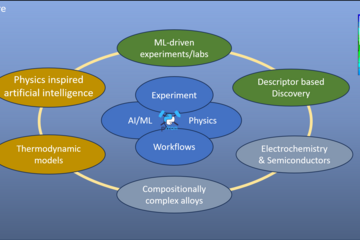All genres
11261.
Thesis - PhD
Structural Analysis and Correlative Cathodoluminescence Investigations of Pr (doped) Niobates. Dissertation, Georessourcen und Materialtechnik, RWTH Aachen (2022)
11262.
Thesis - PhD
Klärung polymerer Anbindungsmechanismen und Untersuchungen Stahloberflächen. Dissertation, Ruhr-Universität Bochum, Fakultät für Maschinenbau (2022)
11263.
Thesis - PhD
Fundamental investigation of the cathodic delamination behaviour of model polymer coating on novel chromium-based coatings electrodeposited from a trivalent chromium-formate electrolyte. Dissertation, Ruhr-Universität Bochum, Fakultät für Maschinenbau (2022)
11264.
Thesis - PhD
The hydrogen electrode in the “dry”: on the effect of electrode material and relative humidity. Dissertation, Ruhr-Universität Bochum, Fakultät für Maschinenbau (2022)
11265.
Thesis - PhD
Advancing the understanding of the microstructure-property relationship in non-toxic and cost-effective thermoelectric Heusler compounds. Dissertation, Fakultät für Georessourcen und Materialtechnik der RWTH Aachen, Germany (2022)
11266.
Thesis - PhD
Development of combinatorial methods to tailor electrical and mechanical properties of Cu-based thin-film structures. Dissertation, Ruhr-Universität Bochum (2022)
11267.
Thesis - PhD
Influence of Processing Parameters, Crystallography and Chemistry of Defects on the Microstructure and Texture Evolution in Grain-Oriented Electrical Steels. Dissertation, RWTH Aachen, Germany (2022)
11268.
Thesis - PhD
Self-heating coatings based on conducting polymer for intelligent corrosion protection. Dissertation, Ruhr-Universität Bochum, Fakultät für Maschinenbau (2022)
11269.
Thesis - PhD
Phase equilibria and phase transformations of Ti–Al–X (X=Nb, Mo, W) alloys for high-temperature structural applications between 700 and 1300 °C. Dissertation, Ruhr-Universität Bochum, Fakultät für Maschinenbau, Germany (2022)
11270.
Thesis - PhD
Grain boundary segregation of boron and carbon and their local chemical effects on the phase transformations in steels. Dissertation, Faculty of Georesources and Materials Engineering of the RWTH Aachen, Germany (2021)
11271.
Thesis - PhD
pyiron – an integrated development environment for ab-initio thermodynamics. Dissertation, Paderborn University, Germany (2021)
11272.
Thesis - PhD
Design of Invar and Magnetic High-Entropy Alloys. Dissertation, RWTH Aachen University (2021)
11273.
Thesis - PhD
Interplay of Real Space and Electronic Structure for Iron-Based Superconductors: An ab initio Study. Dissertation, Ruhr-Universität Bochum, Germany (2021)
11274.
Thesis - PhD
Fundamentals of carbide decomposition and stability. Dissertation, Ruhr-Universität Bochum (2021)
11275.
Thesis - PhD
Development of AlCrFeNiTi Compositionally Complex Alloys for High Temperature Structural Applications. Dissertation, Ruhr-Universität Bochum (2021)
11276.
Thesis - PhD
Engineering Impurities in Colloidal Nanostructures used in ‘Green Hydrogen’ Generation. Dissertation, RWTH Aachen University (2021)
11277.
Thesis - PhD
Crossover-alloys – a new approach for future aluminum alloys. Dissertation, University Leoben, Austria (2021)
11278.
Thesis - PhD
Microstructural characterization of white etching cracks in 100Cr6 bearing steel with emphasis on the role of carbon. Dissertation, RWTH Aachen University (2021)
11279.
Thesis - PhD
Machine learning methods in data-driven nanostructure analysis of materials. Dissertation, RWTH Aachen University (2021)
11280.
Thesis - PhD
Advancements in the understanding of Ir-based water splitting catalysts at the near-atomic scale. Dissertation, Ruhr-Universität Bochum (2021)


